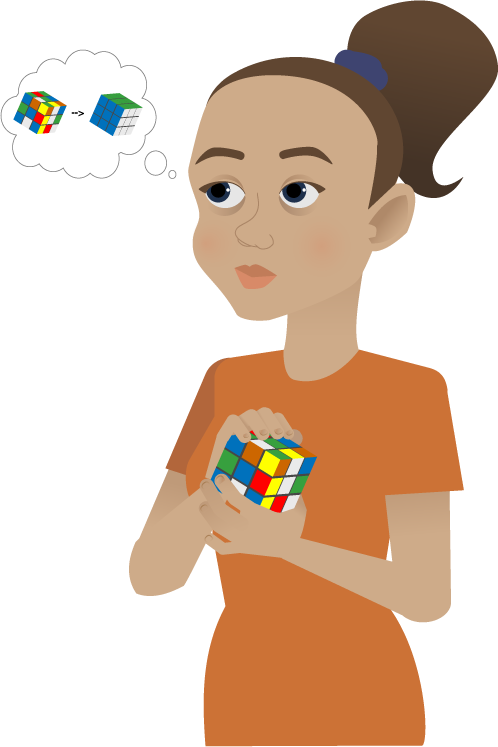This Before You Begin section will help prepare you to start solving your problems. Effective problem-solving requires a calm mind and a cool body. Stress makes it more difficult to think clearly and creatively.
Negative feelings include fear, anger, embarrassment, guilt, and hopelessness. If these feelings are intense or overwhelming, they can interfere with our ability to think logically. Negative thoughts are ideas that focus on the bad things that have happened or may happen in the future without leaving room for constructive thinking about how things can improve.
SIGNS OF STRESS
This list contains some common signs of stress. Review the list and determine if you may be experiencing any signs of stress now. Save the list to continue to monitor your stress signs as needed.
Physical Signs
- Headaches
- Excessive sweating
- Stomach problems
- Tense muscles
- Weight gain or loss
- Sleep problems
- Shortness of breath
- No energy or feeling fatigued
- Loss of sex drive
- Unexplained hair loss
- Rapid heart beat
Behavioral Signs
- Drinking too much
- Using drugs
- Eating more/less than usual
- Sleep problems/difficulty sleeping
- Increased tobacco use
- Increased caffeine use
- Nail biting, hair-twisting
- Pacing
- Grinding your teeth
- “Overdoing” activities
- Acting “bossy”
- Laughing or crying inappropriately
- Yelling or shouting
- Picking fights
- Driving too fast
- Road rage
- Compulsive gambling
- Compulsive buying
- Avoiding friends and family
Emotional Signs
- Anxiety
- Frustration
- Quick irritability with others
- Loss of interest in leisure and play
- Sadness or depressed mood
- Frequent uneasiness, restlessness
- Anger, resentment, hostility
- Feeling pressured or trapped
- Sudden shifts in mood
- Impatience
- Increased mood sensitivity
- Feeling emotionally numb
- Overreacting to unexpected situations
Problems with Thinking
- Trouble concentrating
- Misunderstanding others
- Trouble remembering things
- Poor judgment
- Confusion
- Racing thoughts
- Difficulty making decisions
- Feeling overwhelmed
- Self‐doubt or low self‐confidence
- Criticizing yourself
- Negative “self‐talk”
Define the Problem Tips
Determine if the Problem is Solvable
Determining if the problem can realistically be changed is an important first question in defining the problem. Some situations cannot be changed, but we can find ways to better deal with them. For example, if someone sustained a disabling injury, he may not be able to change his medical condition, but he can find ways to handle it more optimistically and to make the most of his current abilities. Remember, you cannot control the weather, but if you see that rain is in the forecast, you can bring your umbrella or modify your outdoor plans.
Separate Facts from Assumptions
Separating facts from assumptions is a critical part of accurately describing your problem. Sometimes we make assumptions, especially when we are stressed. If we act on assumptions, we are likely to be unsuccessful in solving the problem.
Even if you know that it's important to separate facts from assumptions, it is not always easy to do. Often we don't know we are making assumptions. Therefore, a good rule of thumb is to take some time to think about your problem, and seek out the facts. Look for evidence that supports your description of your problem. Try to make sure you are seeing the whole picture and have all the key information. And once again, it is helpful to ask a friend or colleague for help.
Seeking the Facts
Sometimes people try to solve a problem before they know all the facts. With any situation that is causing distress, however, it is important to seek out information that you might not have at your fingertips. For example, you probably would not impulsively buy a car if you didn't know how much gas mileage it gets, or how often this particular model breaks down. Likewise, it's not a good idea to try to solve a problem before you know most of the facts.
A simple guide to use when seeking facts is to think like a detective or newspaper reporter trying to "get the facts." Ask questions such as "who," "what," "when," "where," and "how." Remember to use clear language when describing these facts. If we don't, we can "blow things out of proportion" or be easily misunderstood. What is "clear" language? Asking trusted friends or colleagues is often a useful way to determine if we are being clear.
Set Realistic Goals
In setting goals, identify ones that are actually attainable. Although we will never discourage you from following your dreams, you are unlikely to be able to reach them unless they are reasonable, and this can lead to feelings of frustration, depression, and failure. If a goal seems too large to try to accomplish for now, follow the simplification principle, that is, break the problem down into smaller ones, while still keeping your "final destination" in mind.
In setting goals, remember that it is important to understand the difference between two types of goals. Problem-focused goals are those that involve changing the nature of a situation so that it is no longer a problem. Such goals are more appropriate where the situation can, in fact, be changed. Examples include saving more money, improving communications with a spouse, or losing weight. On the other hand, emotion-focused goals are those where a situation cannot be changed, or where your emotional reactions are too overwhelming. For example, fear that you may never be able to get a job that is satisfying, while understandable, is likely to cause more harm than good if unchecked. Holding onto resentment, anger, or jealousy are other examples. Therefore, when setting goals, you need to think about which types of goals are appropriate for the problem you are trying to deal with. Problem-focused goals usually require some action; emotion-focused goals often require acceptance, forgiveness, stress management, or other ways of minimizing your negative emotions from becoming overwhelming.
Identify the Obstacles
What makes your situation a problem for you? This is a key question to answer in order for you to correctly "define" your problem. Usually problems involve obstacles to overcome or conflicts to resolve; we may not have the sufficient resources or knowledge to reach a goal, or there may be too many goals to choose from. As with most of life's more difficult problems, there are usually multiple factors that exist that contribute to the problem. Identifying such factors helps us to eventually identify effective solutions.
Obstacles that make a situation a problem may include:
- Barriers: something blocking your path to a goal.
- Conflicting goals: conflicts between yourself and others, or between two opposing goals you have identified.
- Reduced resources : lack of necessary skills or resources that makes reaching your goal very difficult.
- The unknown or unfamiliar: a situation you haven’t encountered before that makes it difficult to know what to do.
- Complexity: the situation seems very complicated and overwhelming.
- Emotional difficulties: your emotional reaction itself is difficult to overcome.
When viewing yourself as a "problem-solving traveler," the question to specifically ask yourself is—"what is preventing me from getting from A (where I am now) to B (where I want to go)? Think about a problem you are currently experiencing—write down what you think are the obstacles, conflicting goals, complexities, lack of resources, emotional difficulties, or unknown/unfamiliar aspects that make your situation a problem. In other words, what kind of roadblocks, long tunnels, expensive tolls, winding roads, or dangerous hills do you need to take into account when "planning your trip" to get to your destination? In doing so, remember to use clear language and to separate facts from assumptions! These obstacles are what you need to overcome in order to solve the problem.
Generate Alternative Solutions
Quantity Leads to Quality
This notion suggests that it is important to generate many solution options because having more solutions increases your chances of eventually identifying high-quality alternatives. Think of the simple example of looking to buy a new pair of pants—what type of store is more likely to have your size and preference, a large store or a small store? Obviously the large one! Having more of a selection allows you to choose the pants that fit you the best! In using the quantity principle, remember to use the externalizing rule of problem-solving multi-tasking; that is, when thinking of a list of ideas–write them down!
Do Not Judge
The second principle recommends that you defer judgment, suggesting that you record every idea that comes to mind in order to increase the number of ideas you can generate. Prematurely rejecting ideas limits creative thinking! Instead, deferring judgment increases your ability to think of effective ideas. For example, even if an idea seems silly or initially impossible, it may spark another related idea that is not silly or impossible. Therefore, you should refrain from evaluating or judging solutions at this time. There is only one criterion to use at present—that the idea be relevant to the problem at hand. Otherwise, remember that there is no "right" or "wrong" alternative at this point— if you catch yourself (even silently) judging any ideas you have, STOP and remind yourself that this will cut down on creativity.
Think of Variety
According to this third principle, the greater the variety of alternatives generated, the more high-quality ideas will be produced. Strategies are general courses of action you can take to handle a problem. Tactics are specific steps involved in putting a given strategy into action. To increase your creativity, look over a list of alternatives and try to identify the various strategies that you generated. For example, strategies to get more money can include: (a) borrow money, (b) steal money (we know this is not a good one, but remember to defer judgment! ), (c) get a second job, (d) cut down on expenses, and so forth. Specific tactics of borrowing money can include (a) borrow from a bank, (b) borrow from cousin John, (c) borrow from a loan shark, (d) borrow from a credit union, (d) borrow from your boss, and so forth. If any of the strategies have few specific tactics, try to generate more. Then try to think of some new strategies and then some new tactics for each new strategy.
Stimulate Your Creativity: Getting Unstuck
If you get “stuck” and cannot think of many alternatives, the following are additional ways to stimulate your creativity:
-
Imagine how someone else may try to solve the problem. Think of someone you admire, such as your best friend, your favorite uncle, the Dali Lama, a sports hero, or your favorite character from a book or movie.
-
Use the visualizing principle. Think of the problem in your imagination, and then visualize yourself attempting to cope with it and achieving your problem-solving goals. Think about differing ways to achieve such goals.
-
Combine differing ideas. This can help to produce new solution alternatives or to modify an alternative to either improve upon it or produce a new one.
If generating multiple alternatives proves a bit difficult for you, one way to improve your basic creativity skills is to practice with "fun" examples. For instance, generate as many ideas as possible regarding what you can do with a "single brick." Believe it or not, within minutes, you can develop a list that can top over 100 ideas if you follow the brainstorming rules. For fun, go ahead and try this practice example. Write down as many ideas as you possibly can regarding different things you can do with a single brick. If you experience some creative blocks, remember the brainstorming principles.
Screen Out Ineffective Solutions
When predicting the consequences or effects of a given alternative, there are a series of questions you should ask.
First, you should try to answer the following two questions about the alternative's effectiveness:
-
Will this solution help me reach my goals?
-
Will I actually be able to carry it out?
A second set of questions involves predicting the personal, social, short-term, and long-term consequences of each alternative.
-
What are the effects on me? (Personal consequences can include: emotional, psychological, and physical well-being; the time and effort required; financial well-being; impact on values.)
-
What are the social consequences? (That is, what are the effects on others, such as family, friends, neighbors, co-workers, etc?)
-
What are the immediate consequences of this alternative?
-
What are the long-range effects of this solution?
Evaluating the Solutions and Alternatives
To identify the solution that is best for you, consider rating each alternative by weighing their pros and cons. (If the problem is simple, you may be able to skip this step.) To evaluate the alternatives, give each idea a rating based on your response to each of the following four questions. The ratings are: plus rating = positive or yes, or minus rating = negative or no. When you are done, each option will have 4 ratings.
- Will this alternative reach my goal?
- Can I carry it out?
- What are the overall effects on myself, both short-term and long-term?
- What are the overall effects on others, both short-term and long-term?
Deciding Which Solution is Best
Look over your ratings for your three solutions and select the best solution that works for you. Effective alternatives are those with the least number of "minuses" and the most number of "plusses." If there are several, you can begin to develop an Action Plan.
If most or all of your alternatives are rated as generally negative, consider whether you correctly defined the problem or generated enough alternatives.
Make and Action Plan
Choose those alternatives that have the best ratings to develop an action plan. This plan may be simple or comprehensive. If you initially identified very few obstacles to your goal, a simple plan requiring only one or two alternatives may be enough. However, sometimes more difficult problems need a more comprehensive action plan. For example, you may wish to choose a combination of several alternatives to be carried out at the same time. This would be appropriate when it seems that such a combination is likely to be more effective than any solution alone, or when there are multiple obstacles that need to be overcome. Many problems in life are complex and involve multiple obstacles to overcome, so identifying several solutions to include in a larger action plan may be advisable.
You may also need to think about contingency plans (that is, what to do in case a given alternative or set of options are not effective).
Once your action plan is prepared, the final step is to fill in the details as to exactly how, when, and where it will be carried out. At this point, write this plan down (Externalize) and/or imagine yourself carrying out the plan (Visualize) in order to consider one last time how good a plan you believe it to be.
Observe and Monitor the Outcome
Just like a doctor takes your blood pressure to determine how a particular medication is working, it is important for you to monitor the outcome of your action plan. Before you made the action plan, you were asked to predict the pros and cons of possible solutions. After you carry out your action plan, collect information to determine if your predictions were correct. Determine if your action plan helped you to reach your goals.
Reward your Efforts
Now is the time to reward yourself for your problem-solving efforts! Rewards could involve buying a new video game or DVD, a new article of clothing, watching your favorite movie, cooking your favorite meal or buying good seats at an upcoming sports event. Maybe your reward is sharing your progress with someone who cares about you or catching up with an old friend. You could also reward yourself by taking some much deserved "me" time to spend doing something you don't normally have time to do. This is to reward your efforts! As such, this does NOT mean that you should limit your self-reward only for successfully resolving the problem, but more so for just trying! Regardless of the results concerning any one problem, by trying to put your Planful Problem-Solving skills to work and monitoring the results, you will always be improving your skills. And that's worth rewarding
Negative Thoughts and Feelings
Negative thoughts and feelings will interfere with your ability to identify effective ways of dealing with problems. Below are some tips for helping you cope with them:
- Be aware of your negative thoughts and feelings.
- Seek evidence to challenge your negative thoughts.
- Accept your negative feelings, but don't let them take over.
- Focus on what you can change, not on things that are unchangeable.
Stress
Your mind can't operate at its best when you are experiencing stress. To reduce the symptoms of stress, do any relaxation exercise that works for you.
- Deep breathing
- Progressive muscle relaxation
- Yawn
- Count slowly from 1-10
- Meditation
- Visualize
- Pray





